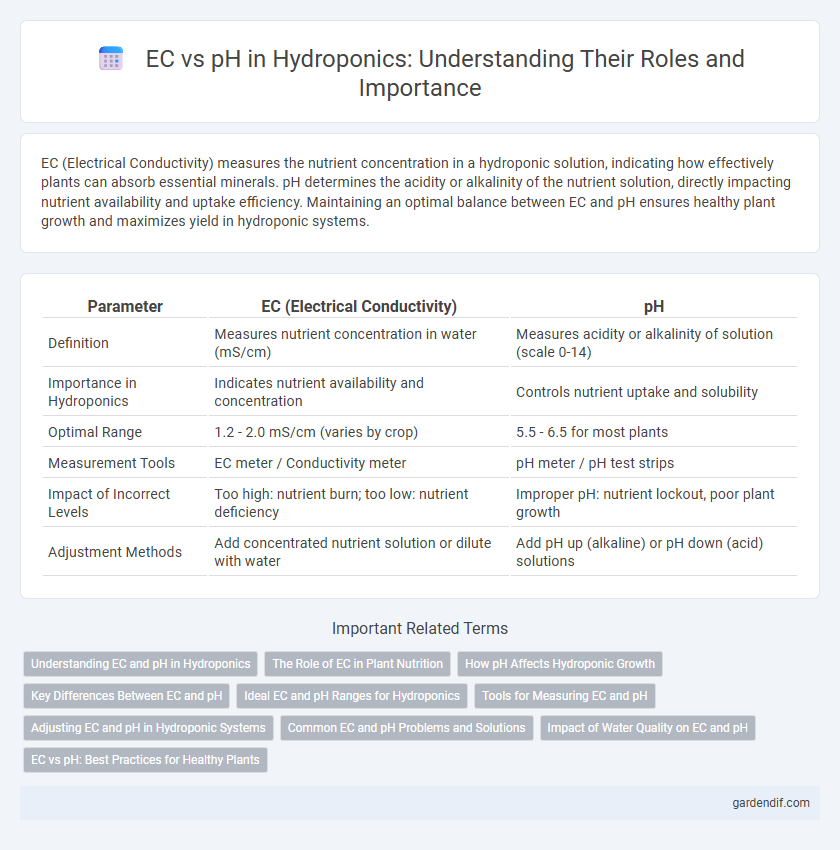
EC vs pH Illustration
EC (Electrical Conductivity) measures the nutrient concentration in a hydroponic solution, indicating how effectively plants can absorb essential minerals. pH determines the acidity or alkalinity of the nutrient solution, directly impacting nutrient availability and uptake efficiency. Maintaining an optimal balance between EC and pH ensures healthy plant growth and maximizes yield in hydroponic systems.
Table of Comparison
| Parameter | EC (Electrical Conductivity) | pH |
|---|---|---|
| Definition | Measures nutrient concentration in water (mS/cm) | Measures acidity or alkalinity of solution (scale 0-14) |
| Importance in Hydroponics | Indicates nutrient availability and concentration | Controls nutrient uptake and solubility |
| Optimal Range | 1.2 - 2.0 mS/cm (varies by crop) | 5.5 - 6.5 for most plants |
| Measurement Tools | EC meter / Conductivity meter | pH meter / pH test strips |
| Impact of Incorrect Levels | Too high: nutrient burn; too low: nutrient deficiency | Improper pH: nutrient lockout, poor plant growth |
| Adjustment Methods | Add concentrated nutrient solution or dilute with water | Add pH up (alkaline) or pH down (acid) solutions |
Understanding EC and pH in Hydroponics
Electrical Conductivity (EC) measures the nutrient concentration in hydroponic solutions, directly influencing plant nutrient uptake efficiency. pH levels determine nutrient availability by affecting solubility and absorption rates, with an optimal range generally between 5.5 and 6.5 for most hydroponic crops. Maintaining balanced EC and pH ensures healthy root development and maximizes growth yield in hydroponic systems.
The Role of EC in Plant Nutrition
Electrical Conductivity (EC) measures the concentration of dissolved salts in hydroponic solutions, directly impacting nutrient availability and uptake by plants. Maintaining optimal EC levels ensures an adequate supply of macro and micronutrients, promoting healthy growth and preventing nutrient deficiencies or toxicities. Unlike pH, which affects nutrient solubility, EC indicates the actual nutrient concentration, making it crucial for precise nutrient management in hydroponic systems.
How pH Affects Hydroponic Growth
pH levels critically influence nutrient availability and uptake in hydroponic systems, directly impacting plant growth and health. An optimal pH range of 5.5 to 6.5 maximizes the absorption of essential nutrients such as nitrogen, phosphorus, and potassium by maintaining nutrient solubility in the solution. Deviations from this range can cause nutrient lockout, leading to deficiencies and stunted plant development despite appropriate EC (electrical conductivity) levels.
Key Differences Between EC and pH
EC (Electrical Conductivity) measures the concentration of dissolved salts and nutrients in hydroponic solutions, directly indicating nutrient availability for plants. pH quantifies the hydrogen ion concentration, determining the acidity or alkalinity of the solution, which affects nutrient solubility and uptake. While EC reflects nutrient strength, pH controls nutrient accessibility, both essential for optimizing hydroponic crop growth.
Ideal EC and pH Ranges for Hydroponics
Ideal EC (Electrical Conductivity) levels for hydroponic systems typically range between 1.0 and 2.5 mS/cm, depending on the plant species and growth stage, ensuring optimal nutrient availability without causing salt buildup. The ideal pH range for hydroponics is generally between 5.5 and 6.5, which maximizes nutrient solubility and uptake efficiency by the plants. Monitoring and maintaining these EC and pH ranges is critical for preventing nutrient deficiencies and promoting healthy, vigorous plant growth in hydroponic setups.
Tools for Measuring EC and pH
Accurate measurement of electrical conductivity (EC) and pH is essential for optimizing hydroponic nutrient solutions. Digital EC meters and pH meters with automatic temperature compensation provide precise readings to maintain nutrient balance and promote healthy plant growth. Portable, handheld devices and advanced, multi-parameter probes allow real-time monitoring and adjustments for efficient hydroponic system management.
Adjusting EC and pH in Hydroponic Systems
Adjusting EC (electrical conductivity) and pH in hydroponic systems is crucial for optimizing nutrient uptake and plant health. Maintaining EC levels between 1.2 and 2.5 mS/cm ensures adequate nutrient concentration, while keeping pH in the 5.5 to 6.5 range promotes nutrient availability and prevents deficiencies or toxicities. Regular monitoring and adjustments using calibration solutions and pH buffers enhance growth efficiency and crop yield in hydroponic setups.
Common EC and pH Problems and Solutions
Common EC problems in hydroponics include nutrient imbalances caused by excessively high or low electrical conductivity levels, which lead to poor plant growth and nutrient deficiencies. pH fluctuations can limit nutrient availability, often resulting in lockout symptoms such as yellowing leaves or stunted growth. Regular monitoring and adjusting EC with nutrient concentration and pH with buffering solutions like phosphoric acid or potassium hydroxide ensure optimal nutrient uptake and healthy plant development.
Impact of Water Quality on EC and pH
Water quality significantly influences Electrical Conductivity (EC) and pH levels in hydroponic systems, as dissolved salts and minerals alter nutrient availability and solution balance. High levels of impurities such as calcium, magnesium, or sodium can increase EC readings while disrupting optimal pH ranges, leading to nutrient lockout and reduced plant growth. Maintaining consistent water quality with proper filtration and monitoring is crucial for stabilizing EC and pH, ensuring efficient nutrient uptake and healthy crop development.
EC vs pH: Best Practices for Healthy Plants
Monitoring EC (electrical conductivity) and pH levels is essential for optimizing nutrient uptake and preventing nutrient lockout in hydroponic systems. Maintaining an EC range of 1.2-2.0 mS/cm and a pH between 5.5-6.5 ensures optimal nutrient solubility and absorption, promoting healthy plant growth. Regular adjustment of nutrient solutions based on EC and pH readings prevents deficiencies and toxicities, supporting robust root development and high yields.
EC vs pH Infographic

 gardendif.com
gardendif.com